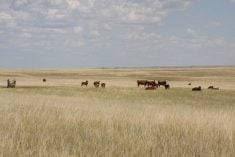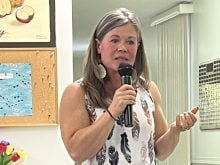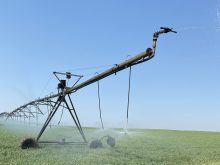Nearly $1 billion that governments have committed to irrigation expansion is expected to add another 200,000 acres
Nearly $1 billion in investment for irrigation expansion across southern Alberta will be the largest in more than 100 years in the province, according to a relatively new consortium of the province’s irrigation districts.
Richard Phillips, Irrigating Alberta chair, outlined the size and scope of the program that will see the more than 1.75 million acres currently under a pivot potentially grow by 200,000 acres.
Phillips said it’s still a big question as to whether that increase in irrigated acres will come to fruition and if it does, there is no designated district in which it will occur or contingency on the investment for it to take place.
Read Also

New coal mine proposal met with old concerns
A smaller version of the previously rejected Grassy Mountain coal mine project in Crowsnest Pass is back on the table, and the Livingstone Landowners Group continues to voice concerns about the environmental risks.
The program is strictly about squeezing the most out of every drop of water, he said.
“Over 40 percent of the world’s food supply depends on irrigation,” said Phillips during a live YouTube presentation hosted by Irrigating Alberta on the expansion projects underway.
“It’s simply the most reliable prevention for famine that we have.”
World population numbers continue to rise, and “Canada is one of the very few countries of the world identified as having the ability to significantly increase its food production to support that growth,” said Phillips.
In terms of food production as well as economic benefits, producers punch above their weight in returns, he added.
Phillips said Irrigating Alberta was started to allow direct negotiations to take place with the Canada Infrastructure Bank.
He said the nature of these negotiations hasn’t allowed for as much transparency for specifics of which projects and where they are going forward due to legal and financial requirements for non-disclosure.
“As a result, there has been very limited communication to the public, which is frustration to us as well as people who would like to know more,” said Phillips.
That includes details of up to four reservoir projects, including Chin and Snake Lake reservoir expansions and a new reservoir at Dead Horse Coulee near Enchant. Those projects will be based in the St. Mary’s, Eastern and Bow River irrigation districts respectively.
“What I can tell you is that all four of them are off-stream reservoirs, the current land use is for all of them agricultural land and that they are on privately owned land which needs to be acquired by the districts,” said Phillips.
But the fourth reservoir project remains a mystery with Phillips explaining that “the district has reasons for not wanting for it to become public yet and we’re all respecting their wishes.”
The key takeaway is that with the variable climate found in southern Alberta, the reservoirs will be able to provide a reliable water resource, he said.
A total of 10 irrigation districts will be part of the investment including eight of the largest and two smaller ones.
It’s not just big government funded projects, stressed Phillips, with much of the investment going towards improving efficiency of already existing infrastructure while 70 percent of the near billion dollars in investment will be loans to the participating districts. The remaining 30 percent will be covered through a direct investment by the Alberta government with any cost overruns being picked up irrigators.
The vast majority of the investment will go toward 92 projects across southern Alberta.
Phillips said “81 of those modernization projects involve replacing existing canals with buried water pipelines, which is the same thing districts have been doing for decades.”
Money will also be put toward automation of infrastructure he added.
All modernization projects are required to be done by 2025 with reservoirs needing to be finished by 2028.
Despite the rapid pace, “nobody is getting a get-out-of-regulation-free card as part of this program,” said Phillips. And no new water licences will be issued from the South Saskatchewan River, which has been under a moratorium since 2006.
“Our existing allocations are all we can ever expect to get and we have to live within those allocations,” he said.


















